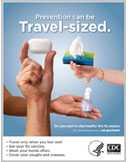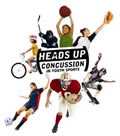December 31, 2009
Mat releases (also known as matte releases or formatted releases) are formatted, ready-to-print articles that are free to use in any publication. CDC′s Formatted Release Library has articles on a variety of important health topics.
December 17, 2009
H1N1: Year in Review. HHS Secretary Sebelius and top experts from HHS, the Centers for Disease Control and Prevention (CDC), the National Institutes of Health (NIH), and the Food and Drug Administration (FDA) will provide updates and give perspective on the H1N1 outbreak and discuss the next phase of the response to the pandemic.
December 1, 2009

CDC has received reports of fraudulent emails (phishing) referencing a CDC sponsored State Vaccination Program. The CDC has NOT implemented a state vaccination program requiring registration on www.cdc.gov. Users that click on the email are at risk of having malicious code installed on their system. CDC reminds users to take the following steps to reduce the risk of being a victim of a phishing attack.
- Do not follow unsolicited links and do not open or respond to unsolicited email messages.
- Use caution when visiting un-trusted websites.
- Use caution when entering personal information online.
November 25, 2009

Every holiday season, millions of Americans travel to spend time with loved ones. Traveling and holiday get-togethers bring people close together and provide an ideal way for illness to spread. To help travelers avoid the flu this holiday season, CDC has launched a public awareness campaign to educate travelers about staying healthy.
- Travel only when you feel well
- Wash your hands often
- Cover coughs and sneezes with a tissue or sleeve
- Get vaccinated for flu (if you are in a priority group)
November 16, 2009

STDs remain a major public health challenge in the United States. CDC estimates approximately 19 million new STD infections each year – almost half of them among young people. A recent report, Sexually Transmitted Disease Surveillance, 2008, found the largest number of reported cases of both chlamydia and gonorrhea in 2008 were among girls between 15 and 19 years of age. CDC estimates that undiagnosed and untreated STDs cause at least 24,000 women in the United States each year to become infertile. When detected early, treatment is relatively simple.
»Learn More
November 12, 2009

Estimating the number of individual flu cases in the United States is very challenging because many people with flu don’t seek medical care and only a small number of those that do seek care are tested. More people who are hospitalized or die of flu-related causes are tested and reported, but under-reporting of hospitalizations and deaths occurs as well. For this reason CDC monitors influenza activity levels and trends and virus characteristics through a nationwide surveillance system and uses statistical modeling to estimate the burden of flu illness (including hospitalizations and deaths) in the United States. »Learn More.
November 3, 2009

Guillain-Barré syndrome (GBS) is a rare disorder in which a person’s own immune system damages the nerves, causing muscle weakness and sometimes paralysis. In 1976, there was a small increased chance of GBS after getting a flu (swine flu) vaccination. Since then, many studies have been done to see if other flu vaccines may cause GBS. In most studies no link was found between the flu vaccine and GBS. However, two studies did suggest that about 1 more person out of 1 million people vaccinated with seasonal flu vaccine may develop GBS. This continues to be studied. For the most part, the chance of getting very ill from flu is far higher than the chance of getting GBS after getting the flu vaccine. »Learn More.
October 7, 2009

Recently there have been several media reports describing unpublished findings from seasonal influenza vaccine studies conducted in Canada. Preliminary results of studies conducted in the United States using methods similar to the Canadian studies did not indicate that receiving a seasonal influenza vaccine increased the risk of developing influenza caused by the 2009 H1N1 influenza virus. In addition, no other country has reported that seasonal influenza vaccine increases the risk of developing influenza caused by the 2009 H1N1 influenza virus. »Learn More.
August 27, 2009

Some recent reports have speculated about the CDC’s upcoming public health recommendations on male circumcision for HIV prevention in the United States. It is important to note that the recommendations are still in development and CDC has made no determination at this time about the final content. For information on the status of CDC’s upcoming recommendations on male circumcision for the prevention of HIV infection in the United States, please visit our statement.
August 4, 2009

Unintentional poisoning is second only to motor vehicle crashes as a leading cause of unintentional injury death in the United States. The poisoning death rate has been rising in recent years and more than doubled between 1999 and 2006. Ninety-five percent of poisoning deaths are a result of drug poisoning – and most of them involve prescription drugs. Thankfully, everyone can take steps to protect someone they care about from being poisoned and help them live to their full potential. >> learn more
July 27, 2009

Each year, between 8,000 and 18,000 people are hospitalized with Legionnaires' disease, caused by a type of bacteria called Legionella, in the U.S. The bacteria got its name in 1976, when many people who went to a Philadelphia convention of the American Legion suffered from an outbreak of this disease, a type of pneumonia or lung infection. A milder infection caused by the same type of Legionella bacteria is called Pontiac Fever.>> learn more
July 20, 2009

Newborn screening identifies conditions that can affect a child's long-term health or survival. Early detection, diagnosis, and intervention can prevent death or disability and enable children to reach their full potential. Each year, millions of babies in the U.S. are routinely screened, using a few drops of blood from the newborn's heel, for certain genetic, endocrine, and metabolic disorders, and are also tested for hearing loss prior to discharge from a hospital or birthing center. >> learn more
July 9, 2009

Two-thirds of people in the United States weigh more than they should and nearly three-quarters don’t get the recommended 30 minutes of physical activity on most days. Because many adults spend 20, 30, or 40 hours or more a week at work, adding physical activity to employee’s workdays may be one way to help working Americans become healthier.
>> learn more
June 30, 2009

Jaundice is the yellow color seen in the skin of many newborns. It happens when a chemical called bilirubin builds up in the baby's blood. Jaundice can occur in babies of any race or ethnicity, regardless of skin color. Low levels of bilirubin are not a problem, but a few babies have too much jaundice. If not treated, high levels of bilirubin can cause brain damage and a life-long condition called kernicterus.
>> learn more
June 26, 2009

About 10 percent of people will experience a seizure sometime during their lifetime and about 3 percent will have had a diagnosis of epilepsy, a chronic neurological condition characterized by recurrent seizures, by age 80. Nearly 150,000 new cases of epilepsy will be diagnosed in the United States in 2009.
>> learn more
June 16, 2009

There are approximately 1.7 million beds in 16,100 nursing homes in the United States. Of those beds, 1.5 million are occupied for an average stay of 835 days. Nearly half of the people living in nursing homes were staying with a family member before being admitted. CDC has developed a guide for caregivers (PDF) as well as health tips for older adults.
>> learn more
June 1, 2009

Healthy Joints
More than 46 million Americans live with arthritis, the term used to describe more than 100 rheumatic diseases and conditions that affect joints, the tissues which surround the joint and other connective tissue. Most forms of arthritis are diagnosed using patient′s history or a physical examination rather than a specific test and can be treated with pain medications, physical activity, weight loss (if overweight), and self-management education. >> learn more
May 26, 2009

Tobacco use is one of the major preventable causes of premature death and disease in the world. According to the World Health Organization approximately 5.4 million deaths per year can be attributed to tobacco use (or one in 10 deaths among adults worldwide), a number expected to exceed 8 million per year by 2030. Celebrate World No Tobacco Day May 31st by learning the consequences of secondhand smoke, understanding health disparities and find information on how to quit. >> learn more
April 27, 2009

Each day, nearly 12,000 babies are born in the United States who will need to be immunized against 14 vaccine-preventable diseases before age two. Vaccine-preventable diseases are at an all-time low in the United States. But because of the success of vaccines in preventing disease in the U.S., parents are often unaware that their children are at risk for so many serious and life-threatening diseases. Celebrate National Infant Immunization Awareness week by finding out the latest recommendations from CDC. >> learn more
April 22, 2009

As many as 3.8 million sports- and recreation-related concussions occur in the United States each year. The potential for concussions is greatest in athletic environments where collisions are common, though the potential for a concussion can occur in any organized or unorganized sport or recreational activity. CDC developed factsheets and educational materials for coaches, parents and players. Make sure you’re staying safe on the court and in the yard. >> learn more
April 13, 2009

The Nation is growing more diverse and the related health and healthcare needs of its population are changing. The percentage of the population that is of Hispanic or Asian origin has more than double since 1980. Between 1970 and 2004, the percentage of the U.S. population that was foreign-born also more than double. CDC′s Office of Minority Health works to lessen health disparities based on race.
>> learn more
April 7, 2009

A new campaign to refocus national attention on the HIV epidemic in the United States was launched at the White House on Tuesday, April 7. Act Against AIDSis a five-year, multi-faceted communication campaign, with an initial phase to directly address complacency by reminding all Americans of the significant health threat of HIV in their own country. “9½ minutes” is the theme, and the message is simple: Right here in the United States, every 9½ minutes, someone’s brother, mother, sister, father, or neighbor is infected with HIV.
>> learn more
April 3, 2009

American travelers may not realize the flu season in Argentina and Australia and other countries south of the equator runs April through September. Influenza is the most frequently acquired vaccine-preventable disease among travelers to tropical and subtropical countries. See CDC updated recommendations for those traveling abroad.
>> learn more
April 2, 2009

According to a recent report, the rate of having a child with an autism spectrum disorder (ASD), such as autism, increases with maternal and parental age. ASDs are developmental disabilities that can cause mild to severe impairments in social interaction and communication and the presence of unusual behaviors and interests. In recognition of Autism Awareness Month, find out more about learning the signs and how you can act early to help your child reach his or her full potential.
» learn more
March 31, 2009

The transmission of onchocerciasis or river blindness has been stopped in Escuintla, Guatemala, one of the largest endemic areas in the Western Hemisphere to date to stop the transmission of the parasitic disease. The findings, published March 31st in the open-access journal PLoS Neglected Tropical Diseases, detail the lack of ocular lesions and the absence of infections in school children as well as in the black fly which spreads the disease.
» learn more
March 27, 2009

Among cancers that affect both men and women, colorectal cancer—cancer of the colon or rectum—is the second leading cause of cancer-related deaths in the United States. Colorectal cancer also is one of the most commonly diagnosed cancers in the United States. The risk of developing colorectal cancer increases with advancing age. More than 90% of cases occur in people aged 50 or older.
» learn more
March 18, 2009

A traumatic brain injury (TBI) is caused by a blow or jolt to the head or a penetrating head injury that disrupts the normal function of the brain. Not all blows or jolts to the head result in a TBI. Of the 1.4 million who sustain a TBI each year in the United States: 50,000 die; 235,000 are hospitalized; and 1.1 million are treated and released from an emergency department.
» learn more
March 13, 2009

Kidney disease causes almost 50,000 deaths per year and is the No. 9 leading cause of death for men and women. As a disease multiplier, meaning that it can contribute to the cause of death in people with diabetes and hypertension, kidney disease is a serious public health threat.
» learn more
March 5, 2009

According to the recently released Health U.S. 2008, women live 5.2 years longer than men. Celebrate Women’s History Month finding out what women around you do to help live longer and healthier lives. Perhaps they are good at balancing calories, keeping their bones strong, or strength training.» learn more
February 25, 2009

It′s important to indulge every now and then, but knowing the basics of nutrition is essential to a healthy lifestyle. Find information on food groups, water, dietary fat, carbohydrates, protein and vitamins and minerals along with other resources outside of CDC. » learn more
February 19, 2009

The 2008 State of CDC has just been released! The summary report provides an overview of the CDC’s recent science and public health efforts as well as highlights significant accomplishments in science, partnership and emergency preparedness. The report also identifies some of the important challenges facing public health in 2009. » learn more
January 27, 2009

In 2007, only 21.4% of high school students reported eating fruits and vegetables five or more times daily (when fried potatoes and potato chips are excluded) during the past 7 days. And as research shows, prevalence of obesity among children has doubled in the last 30 years. Fruits and vegetables are part of a healthy lifestyle and you can find out how many servings you need and how they can help you manage your weight. >> learn more
January 23, 2009

An update on Hib Disease and Hib Vaccines for parents and providers is available here.
http://www.cdc.gov/vaccines/vpd-vac/hib/providers-parents.htm
January 22, 2009

As the list of recalled products associated with the Salmonella Typhimurium outbreak continues to grow, CDC encourages the public to check the FDA′s list of recalled products. For information about the outbreak and salmonella symptoms please visit CDC′s salmonella web site.
January 20, 2009

The U.S. spends more than $2 trillion on health care every year, but we are ranked 30th among the worlds healthiest nations. Find out more about what CDC is doing to make the U.S. a healthiest nation. » learn more
January 12, 2009

Cardiovascular disease caused about a death a minute among women in 2004. That translates to more deaths due to heart disease and stroke than cancer, chronic lower respiratory disease, Alzheimer′s disease, accidents and diabetes combined. CDC′s WISEWOMAN program seeks to build a world where any woman can access preventive health services and gain the wisdom to improve her health. » learn more
January 8, 2009

Salmonella, a group of bacteria that can cause diarrheal illness, are microscopic living creatures that pass from the feces of people or animals to other people. Most persons infected with Salmonella develop diarrhea, fever, and abdominal cramps 12 to 72 hours after infection. For more information on the ongoing, multistate salmonella outbreak, click here.
January 5, 2009

Neural tube defects (NTDs), major birth defects of a baby’s brain or spine such as spina bifida and anencephaly, are preventable. Affecting 3,000 pregnancies a year, NTDs can be prevented by taking B vitamin folic acid before and during pregnancy. Help CDC celebrate National Folic Acid Awareness Week » Learn more
Get email updates
To receive email updates about this site, enter your email address:
Contact Us:
- Centers for Disease Control and Prevention
1600 Clifton Rd
Atlanta, GA 30333 - 800-CDC-INFO
(800-232-4636)
TTY: (888) 232-6348 - Contact CDC-INFO



